Best Walking Shoes with Arch Support for Adults Over 55
This guide explains how to choose walking shoes with arch support for adults over 55. It covers essential shoe features, how to find the right fit, and specific recommendations for conditions like plantar fasciitis and arthritis. The right footwear can improve stability, reduce pain, and help prevent falls.
Why Arch Support Matters
The feet provide the foundation for the body’s interconnected skeletal structure. Misalignment in the feet, such as unsupported arches, can affect the ankles, knees, hips, and spine, contributing to chronic pain. For example, collapsed arches can cause the foot to roll inward (overpronation), stressing the knee and leading to lower back pain.
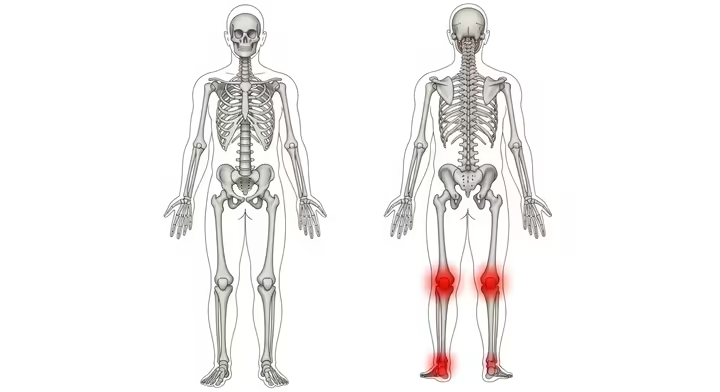
The foot’s ability to absorb shock and propel the body forward comes from its three arches, the medial longitudinal, lateral longitudinal, and transverse. During walking, these arches flatten to absorb impact and then stiffen to push off the ground. The effectiveness of this system depends on an individual's specific foot type.
Common Foot Arch Types
A neutral arch allows for a normal amount of inward roll (pronation) for efficient shock absorption and even weight distribution. In contrast, flat feet (pes planus) have a low arch, which can lead to overpronation and strain on tendons. High arches (pes cavus) are often rigid, reducing shock absorption and concentrating pressure on the heel and ball of the foot.
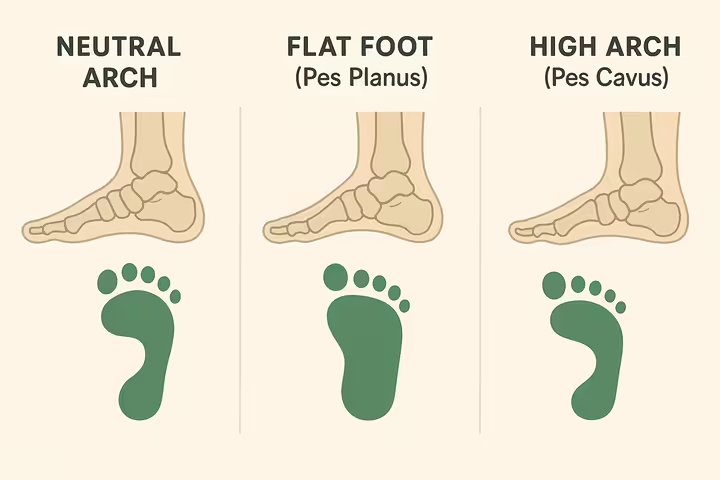
Improving Stability and Preventing Falls
Age-related changes in gait, such as slower speed and shorter steps, are the body's attempt to increase stability. Proper arch support creates a stable foundation that improves dynamic balance and reduces side-to-side sway, a key predictor of fall risk. This support counteracts age-related instability, promoting a safer and more confident gait.
Anatomy of a Supportive Walking Shoe
Each component of a walking shoe works together to provide stability and cushioning. Understanding these features helps in selecting footwear that promotes foot health and reduces fall risk. A failure in one component can compromise the entire shoe's performance.
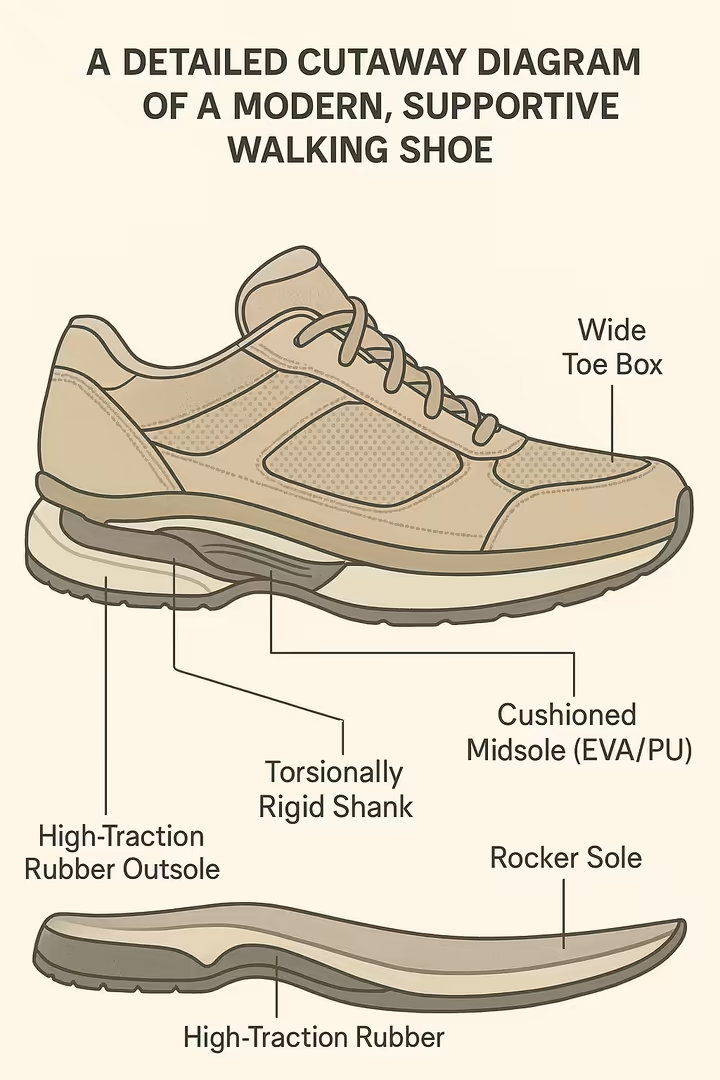
Midsole Materials: EVA vs. PU
The midsole, located between the insole and outsole, is responsible for shock absorption and stability. Ethylene-vinyl acetate (EVA) is a lightweight foam that offers soft cushioning but compresses over time, losing its supportive properties. Polyurethane (PU) is a denser, heavier plastic that is far more durable and resistant to compression, making it a better choice for maximum stability and longevity.
| Feature | Ethylene-Vinyl Acetate (EVA) | Polyurethane (PU) |
|---|---|---|
| Cushioning Feel | Soft, flexible, and responsive initially. | Firmer, denser, and more stable. |
| Durability/Lifespan | Lower; compresses and loses cushioning over 300-500 miles. | Higher; highly resistant to compression and wear, lasting much longer. |
| Weight | Significantly lighter, reducing fatigue. | Heavier and more substantial. |
| Stability | Provides less motion control; better for neutral foot types. | Provides excellent motion control and firm support. |
| Cost | Generally less expensive. | Generally more expensive due to material longevity. |
| Ideal User Profile | Individuals seeking a lightweight, flexible feel who replace shoes regularly. | Individuals needing maximum durability, motion control, and long-term support. |
Essential Structural Components
A firm heel counter, the plastic insert at the back of the shoe, anchors the heel to prevent excessive side-to-side motion and improve stability. The outsole should be made of high-traction rubber with a multi-directional tread to provide grip and prevent slips, especially on wet surfaces. Good walking shoes should also resist twisting through the midfoot (torsional rigidity) but bend easily at the ball of the foot, which prevents the arch from collapsing and maintains proper alignment.
Rocker Soles
A rocker sole has a curved, thicker-than-average profile that encourages a smooth rolling motion from heel to toe. This design reduces the amount of bending required at the ankle and toe joints. For individuals with arthritis or limited joint mobility, a rocker sole can decrease stress, conserve energy, and make walking less painful.
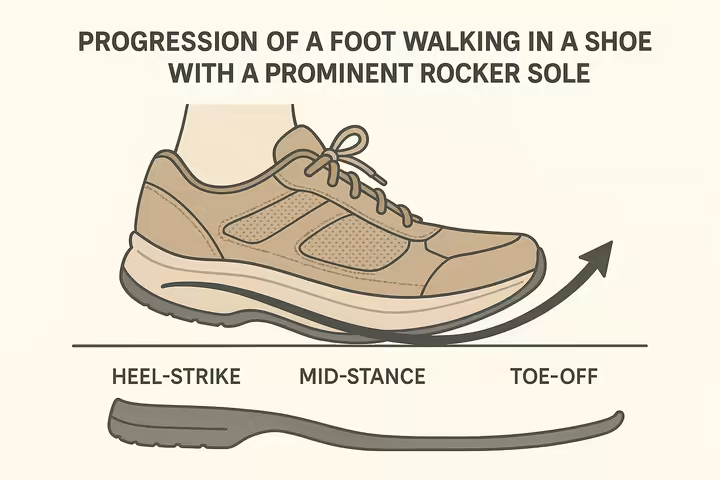
Shoe Recommendations for Common Foot Conditions
Choosing footwear requires matching specific shoe features to an individual's medical needs. The right shoe can alleviate pain and improve function, while the wrong one can worsen existing conditions.
Plantar Fasciitis
To reduce strain from plantar fasciitis, a shoe needs firm, non-flexible arch support to prevent the arch from collapsing. A deep, cushioned heel cup absorbs impact, and a firm heel counter limits movement that can irritate the fascia. Rocker-bottom soles can also be helpful by reducing tension during the toe-off phase of walking.
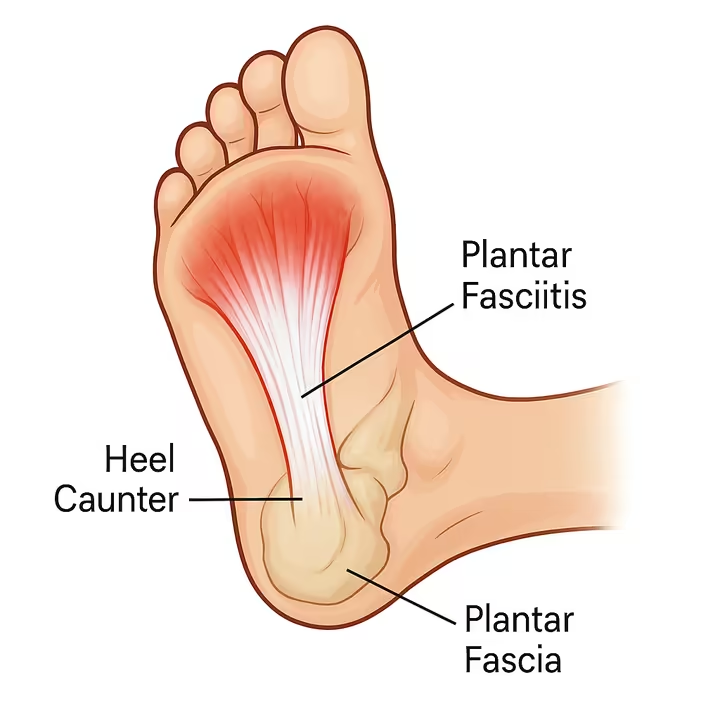
Osteoarthritis
For osteoarthritis in the lower body joints, shoes should prioritize shock absorption. Thick, cushioned midsoles dampen ground forces, and a rocker sole is especially important for foot arthritis. A rocker design reduces the need for the toes to bend, allowing for a smoother, less painful stride.
Overpronation and Flat Feet
Individuals with overpronation or flat feet need "stability" or "motion control" shoes with high torsional rigidity and a firm heel counter. These shoes often use a firmer section of foam on the inner side of the midsole, known as a medial post, to counteract the foot's inward roll. Newer designs use guide rail systems that act like bumpers to keep the foot aligned.
Bunions and Hammertoes
To accommodate forefoot deformities like bunions and hammertoes, a shoe must have a wide, deep, and anatomically shaped toe box. This space allows the toes to lie flat without pressure or rubbing. Uppers made of soft, flexible, and seamless materials like stretch knit fabric are ideal because they conform to the foot's shape.
Diabetes and Peripheral Neuropathy
Footwear for people with diabetes or neuropathy must focus on preventing injury from unnoticed friction. These shoes require a soft, seamless interior lining, extra depth to accommodate custom orthotics or swelling, and a wide, protective toe box. Adjustable, non-binding closures like Velcro straps ensure a secure fit without creating pressure points.
Finding the Right Fit
A correct fit is essential for comfort and safety, particularly as feet change with age. Shoe design and sizing must account for anatomical differences to provide effective support.
Gender-Specific Shoe Design
Men's and women's feet have different anatomical structures. Women typically have a narrower heel relative to their forefoot width, higher arches, and a shallower instep. Shoes built on a gender-specific last (the mold a shoe is built around) accommodate these differences, preventing issues like heel slippage and ensuring proper support.
Sizing for Aging Feet
Feet often become longer and wider with age as arches lower and soft tissues spread. It is important to have both feet measured regularly, as one is often larger than the other. Always fit the shoe to the larger foot.
A wide, high-volume toe box is the most important sizing feature, as it allows the toes to spread naturally, which improves stability. When standing, there should be a finger's width of space between the longest toe and the front of the shoe. The heel should be snug with no slipping, and the shoe should feel comfortable immediately without a "break-in" period.
Recommended Shoe Models and Research
Modern walking shoes benefit from running shoe technology, offering advanced cushioning and stability systems. Brands like Brooks, Hoka, and Saucony have lightweight, biomechanically engineered models well-suited for older walkers.
| Model | Best For | Key Stability Features | Cushioning Level | Noteworthy Features | APMA Seal |
|---|---|---|---|---|---|
| Brooks Adrenaline GTS 24 | Stability / Overpronation | GuideRails system, firm heel counter, wide base, 12 mm drop | Firm but Protective | Excellent for heel strikers; durable; available in multiple widths | Yes |
| Hoka Bondi 9 | Max Cushioning / Arthritis | Extremely wide platform, moderate rocker sole, high midsole sidewalls | Maximalist / Plush | Exceptional shock absorption; can feel bulky; has a narrower toebox | Yes |
| Saucony Guide 17 | Balanced Stability / Value | CenterPath Technology (wide base, sidewalls), mild rocker | Moderate / Firm | Highly breathable upper; versatile for walking; great value | Yes |
| Brooks Addiction Walker 2 | Plantar Fasciitis / All-Day Wear | Strong medial post for motion control, slip-resistant outsole | Balanced / Supportive | Durable leather upper; available with Velcro closures; orthotic-friendly | Yes |
| New Balance 928v3 | Motion Control / Severe Overpronation | ROLLBAR stability post system, firm PU midsole | Firm / Maximum Support | Classic motion-control design; leather construction for durability | Yes |
| Orthofeet / Dr. Comfort Models | Diabetes / Sensitive Feet | Extra-depth design, seamless interior, stretchable uppers | Protective / Accommodative | Focus on injury prevention and accommodating deformities | Yes |
Supportive vs. Minimalist Shoes
While most evidence supports the use of cushioned, supportive shoes, some research explores the benefits of minimalist footwear for strengthening the foot's muscles. Evidence for older adults is mixed, with some studies showing improved stability and others finding no significant benefit compared to supportive shoes. The minimalist approach should be considered with caution and preferably with professional guidance.
A Practical Guide to Shoe Fitting and Care
Applying knowledge about footwear is the final step in ensuring foot health. This guide provides advice on shoe replacement, fitting, and accessories.
When to Replace Your Shoes
Walking shoes wear out and should be replaced every 300 to 500 miles, or about every six months for someone who walks 30 minutes a day. The midsole foam is the first component to fail, losing its ability to absorb shock long before the tread shows wear. Signs of a worn-out shoe include horizontal creases in the midsole foam, a sole that feels hard, or new aches and pains in your feet and joints.
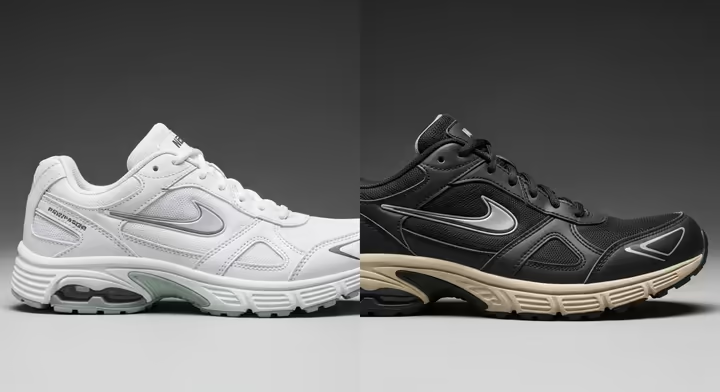
How to Achieve a Proper Fit
Shop for shoes in the late afternoon when your feet are at their largest size. Wear the same type of socks you use for walking. A properly fitted shoe should feel comfortable immediately and provide a snug heel fit with a roomy toe box.
Orthotics and Socks
If you use custom or over-the-counter orthotics, choose "orthotic-friendly" shoes with a removable factory insole to ensure proper fit and function. Pair your shoes with socks made from moisture-wicking fibers like Merino wool or synthetic blends. Avoid 100% cotton socks, which retain moisture and can cause blisters and fungal infections.
Summary of Recommendations
For adults over 55, choosing the right walking shoe is a health decision that improves stability and reduces pain. Because the foot is the body's foundation, a supportive shoe helps prevent pain in the ankles, knees, hips, and back. Investing in quality footwear is a proactive step toward maintaining mobility and preventing falls.
Prioritize shoes with a firm heel counter, a wide and slip-resistant outsole, and a torsionally rigid midsection. A wide toe box is essential to allow toes to spread naturally. To get the right fit, shop in the afternoon, wear your usual socks, and ensure there is a finger's width of space at the front of the shoe.
Works cited
- The Kinetic Chain and the Foot-Spine Connection | Foot Levelers, https://www.footlevelers.com/blog/the-kinetic-chain-and-the-foot-spine-connection
- Why's arch support so important? - Fulton Insoles, https://www.walkfulton.com/blogs/learn/alignment
- Are Your Feet Making Your Back Hurt? How Improving Your Kinetic Chain Can Help You Fix Back Pain - Support the Foot, https://www.supportthefoot.com/blog/how-weak-foot-arches-can-cause-back-pain-strengthening-kinetic-chain/
- Musculoskeletal Conditions of the Foot and Ankle: Assessments and Treatment Options - PMC - PubMed Central, https://pmc.ncbi.nlm.nih.gov/articles/PMC3414868/
- Anatomy, Bony Pelvis and Lower Limb: Arches of the Foot ... - NCBI, https://www.ncbi.nlm.nih.gov/books/NBK587361/
- The Arches of the Foot - Longitudinal - Transverse - TeachMeAnatomy, https://teachmeanatomy.info/lower-limb/misc/foot-arches/
- Biomechanics - The arches of the foot, https://www.baer-shoes.co.uk/magazin-biomechanics-the-arches-of-the-foot/
- Biomechanics of the Foot and Ankle | Request PDF - ResearchGate, https://www.researchgate.net/publication/383225669_Biomechanics_of_the_Foot_and_Ankle
- Normal Biomechanics of the Foot and Ankle - jospt, https://www.jospt.org/doi/pdf/10.2519/jospt.1985.7.3.91
- Neutral Running Shoes Explained; How Gait Impacts Your Shoe Choice - The Run Hub, https://therunhub.ie/blogs/the-run-hub-blog/neutral-running-shoes-explained-how-gait-impacts-your-shoe-choice
- Foot Biomechanics - Gait Analysis, Overpronation & Supination - Sports Injury Clinic, https://www.sportsinjuryclinic.net/treatments-therapies/foot-biomechanics-gait-analysis
- How Foot Biomechanics Impact Mobility - Choice Podiatry Center, https://www.choicepodiatrycenter.com/blog/how-foot-biomechanics-impact-mobility
- Pes Cavus High Arch Feet - Perform Podiatry, https://www.performpodiatry.co.nz/foot-problems/pes-cavus-high-arch-feet/
- Pes Cavus - Physiopedia, https://www.physio-pedia.com/Pes_Cavus
- Foot Posture and Plantar Pressure during Gait in Elderly: A ..., https://www.hilarispublisher.com/proceedings/foot-posture-and-plantar-pressure-during-gait-in-elderly-a-comparison-of-normal-planus-and-cavus-feet-12295.html
- Gait Disorders in Older Adults - Geriatrics - Merck Manual Professional Edition, https://www.merckmanuals.com/professional/geriatrics/gait-disorders-in-older-adults/gait-disorders-in-older-adults
- Gait Disorders in Older Adults - Older People's Health Issues - Merck Manuals, https://www.merckmanuals.com/home/older-people-s-health-issues/gait-disorders-in-older-adults/gait-disorders-in-older-adults
- Efficacy of different insole designs on fall prevention of the elderly, https://www.iaarc.org/publications/fulltext/Efficacy_of_different_insole_designs_on_fall_prevention_of_the_elderly.pdf
- Gait Biomechanics for Fall Prevention among Older Adults - MDPI, https://www.mdpi.com/2076-3417/12/13/6660
- Gait Biomechanics for Fall Prevention among Older Adults - ResearchGate, https://www.researchgate.net/publication/361720147_Gait_Biomechanics_for_Fall_Prevention_among_Older_Adults
- Features of a walking shoe - Mayo Clinic, https://www.mayoclinic.org/healthy-lifestyle/fitness/multimedia/walking-shoe/img-20307328
- Performance Midsoles - Meindl USA, https://meindlusa.com/blogs/meindl-blog/performance-midsoles
- Discover the Benefits of Midsole Materials: PU or EVA? | Thorogood®, https://thorogoodusa.com/eva-pu-midsole/
- What is the difference between EVA and PU insoles? - News - Jinjiang Taiyuan Shoes Material Co.,Ltd, https://www.taiyuanshoematerials.com/news-show-3.html
- The Heel Counter - framas, https://framas.com/2022/11/23/the-heel-counter/
- Footwear Feature: Heel Counter, https://standyourground.ca/blog/257-heel-counter
- The role of heel counters in running shoes | RunRepeat, https://runrepeat.com/guides/the-role-of-heel-counters-in-running-shoes
- Selecting the Best Shoes for Senior Fall Prevention [2024], https://caringseniorservice.com/blog/selecting-the-proper-footwear-for-seniors/
- Best Walking Shoes for Older Adults - Juniper Communities, https://junipercommunities.com/best-walking-shoes-for-older-adults/
- Grip Shoe Technology for Anti-Slip & Non-Slip Shoes - Clarks, https://www.clarks.com/en-us/technologies/grip/move-no-matter-what
- Enhancing Footwear Safety for Fall Prevention in Older Adults: A Comprehensive Review of Design Features - PubMed Central, https://pmc.ncbi.nlm.nih.gov/articles/PMC11217662/
- The Best Walking Shoes For Seniors That Are Stable And Comfortable - Forbes, https://www.forbes.com/sites/forbes-personal-shopper/article/best-walking-shoe-for-seniors/
- As 'Rocker' Style shoes gain popularity, this is what you need to know. | Gotham Footcare, https://www.gothamfootcare.com/blog/as-rocker-style-shoes-gain-popularity-this-is-what-you-need-to-know/
- Rocker Bottom Shoes - The New Standard in Running Shoes - TFC Podiatry, https://www.tfcpodiatry.com.au/rocker-bottom-shoes-the-new-standard/
- How Do Rocker Sole Shoes Work? - Highett Podiatry, https://www.highettpodiatry.com.au/how-rocker-sole-shoes-work/
- Women's Shoes For Arthritis - Flow Feet Orthopedic Shoes, https://flowfeet.com/47-womens-arthritis-shoes
- Shoes: Finding the Right Fit - OrthoInfo - AAOS, https://orthoinfo.aaos.org/en/staying-healthy/shoes-finding-the-right-fit/
- 7 Best Walking Shoes For Overpronation in 2025 | RunRepeat, https://runrepeat.com/guides/best-overpronation-walking-shoes
- Influence of altered torsional stiffness through sole modification of air pressure shoes on lower extremity biomechanical behaviour during side-step cutting maneuvers - PMC, https://pmc.ncbi.nlm.nih.gov/articles/PMC10903810/
- (PDF) Optimizing footwear for older people at risk of falls, https://www.researchgate.net/publication/24032887_Optimizing_footwear_for_older_people_at_risk_of_falls
- (PDF) Enhancing Footwear Safety for Fall Prevention in Older Adults: A Comprehensive Review of Design Features - ResearchGate, https://www.researchgate.net/publication/377589630_Enhancing_footwear_safety_for_fall_prevention_in_older_adults_A_comprehensive_review_of_design_features
- 7 Best Cushioned Walking Shoes in 2025 - RunRepeat, https://runrepeat.com/guides/best-cushioned-walking-shoes
- Shoe Recommendations for Older Adults - Institute of Clinical Excellence, https://ptonice.com/shoe-recommendations-for-older-adults/
- Best Shoes For Plantar Fasciitis 2025 - Forbes Vetted, https://www.forbes.com/sites/forbes-personal-shopper/article/best-shoes-plantar-fasciitis/
- 7 Best Walking Shoes For Plantar Fasciitis in 2025 - RunRepeat, https://runrepeat.com/guides/best-plantar-fasciitis-walking-shoes
- The 8 Best Walking Shoes of 2025 - Most Comfortable Shoes - Runner's World, https://www.runnersworld.com/gear/a23554492/walking-shoes/
- 7 Best Stability Walking Shoes in 2024 - RunRepeat, https://runrepeat.com/guides/best-stability-walking-shoes
- The 7 Best Shoes for Bunions, According to Podiatrists - Health, https://www.health.com/style/best-shoes-bunions
- What shoes are good for bunions? Advice from a Podiatrist - The Bunion Institute, https://www.bunioninstitute.com/blog/good-for-bunions/
- Hammertoe Shoes | Dr. Comfort, https://www.drcomfort.com/foot-indications/hammertoes
- Diabetic Shoes For Women - Casual, Boots, Slippers & More | Flow Feet, https://flowfeet.com/51-womens-diabetic-shoes
- Diabetic Orthopedic Shoes - Orthofeet, https://www.orthofeet.com/collections/diabetic-shoes
- Diabetic Friendly Shoes - The Walking Company, https://www.thewalkingcompany.com/pages/diabetic-friendly
- GENDER DIFFERENCES IN FOOT SHAPE INTRODUCTION METHODS RESULTS - ResearchGate, https://www.researchgate.net/profile/Thomas_Horstmann/publication/253463899_GENDER_DIFFERENCES_IN_FOOT_SHAPE/links/00b4952aefd6f1f54d000000/GENDER-DIFFERENCES-IN-FOOT-SHAPE.pdf?origin=publication_detail
- Biomechanics & Differences Between Men and Women - Foot and Ankle Specialists of the Mid-Atlantic, https://footandankle-usa.com/womens-foot-health/biomechanics-differences-between-men-and-women/
- Female vs male feet - are they different? – she wear, https://www.shewear.com.au/pages/the-difference-between-men-and-womens-feet
- Do Women Need Different Footwear to Men? - V12 Footwear Blog, https://blog.v12footwear.com/do-women-need-different-footwear-to-men
- (PDF) Foot Examination for Older Adults - ResearchGate, https://www.researchgate.net/publication/343659323_Foot_Examination_for_Older_Adults
- The Overlooked Comfort: Embracing Wide Toe Box Shoes, https://revivalperformancept.com/the-overlooked-comfort-embracing-wide-toe-box-shoes-for-happy-feet/
- 10 Reasons Why Wide Toe Box Shoes Are a Game Changer for Foot Health - Bearefoot, https://bearefoot.com/blogs/news/10-reasons-why-wide-toe-box-shoes-are-a-game-changer-for-foot-health
- Wide Toe Box Shoes: The Ultimate Guide for Pain-Free Feet, https://splayshoes.com/blogs/news/wide-toe-box-shoes
- Cut in half: Brooks Adrenaline GTS 24 Review (2025) | RunRepeat, https://runrepeat.com/brooks-adrenaline-gts-24
- Cut in half: Hoka Bondi 9 Review (2025) | RunRepeat, https://runrepeat.com/hoka-bondi-9
- Saucony Guide 18 Review: No Changes, No Problem - Believe in the Run, https://believeintherun.com/shoe-reviews/saucony-guide-18-review/
- Cut in half: Saucony Guide 18 Review (2025) | RunRepeat, https://runrepeat.com/saucony-guide-18
- Orthotic-Friendly Walking Shoes | Comfort & Support, https://mastshoes.com/collections/orthotic-friendly-walking-shoes
- New Balance Walking Shoe Reviews - RunRepeat, https://runrepeat.com/catalog/new-balance-walking-shoes
- APMA Certified Shoes: Podiatrist Approved – Orthofeet®, https://www.orthofeet.com/collections/apma-certified-shoes
- Full article: The effects of minimal shoes in combination with textured and supportive insoles on spatiotemporal walking gait parameters in healthy young adults, https://www.tandfonline.com/doi/full/10.1080/19424280.2024.2410296
- Minimalist Footwear in the Treatment and Rehabilitation of Lower Limb Impairments Across the Life Course: A Scoping Review, https://pmc.ncbi.nlm.nih.gov/articles/PMC12103103/
- Enhancing Footwear Safety for Fall Prevention in Older Adults: A Comprehensive Review of Design Features - PubMed, https://pubmed.ncbi.nlm.nih.gov/38246912/
- Enhancing Footwear Safety for Fall Prevention in Older Adults: A Comprehensive Review of Design Features, http://e-agmr.org/upload/pdf/agmr-23-0167.pdf
- A game-changing gait lab in a shoe - JHU Hub - Johns Hopkins University, https://hub.jhu.edu/2025/05/09/national-institute-on-aging-2025-start-up-challenge/
- How Do I Know When It Is Time To Replace My Athletic Shoes, http://www.aapsm.org/replace_shoes.html
- When Should You Replace Walking Shoes? - Verywell Fit, https://www.verywellfit.com/when-should-i-replace-my-walking-shoes-3436325
- Top Five Signs Your Running Shoes Are Worn Out – My FootDr, https://www.myfootdr.com.au/2020/08/top-five-signs-your-running-shoes-are-worn-out/
- 3 Signs that It's Time to Replace Your Walking Shoes - Pasco-Hernando Foot & Ankle, https://footdrkales.com/blog/3-signs-that-its-time-to-replace-your-walking-shoes
- Signs It's Time to Replace Your Running Shoes: A Checklist - Israel Hayom, https://www.israelhayom.com/shopping/article/signs-it-s-time-to-replace-your-running-shoes-a-checklist/
- When Should You Replace Walking Shoes? - Kane Footwear, https://kanefootwear.com/blogs/kane-blog/when-to-replace-walking-shoes
- When to Replace Your Running Shoes | Runners Need, https://www.runnersneed.com/expert-advice/gear-guides/replace-running-shoes.html
- How to Buy Walking Shoes That Fit - Arthritis Foundation, https://www.arthritis.org/health-wellness/healthy-living/physical-activity/walking/how-to-buy-walking-shoes-that-fit
- 10 Points of Proper Shoe Fit | FootCareMD, https://www.footcaremd.org/resources/how-to-help/10-points-of-proper-shoe-fit#:~:text=Stand%20up%20and%20make%20sure,slip%20or%20slide%20while%20walking.
- APMA Seal Program Footwear & Products - APMA MAIN, https://www.apma.org/patients-and-the-public/apma-seal-program-footwear-products/?srchTerm=27|15
- Merino Wool vs. Cotton: The Best Diabetic Socks | Sockwell, https://sockwellusa.com/blogs/blog/merino-wool-vs-cotton-the-best-diabetic-socks
- The Best Socks for Sweaty Feet, Tested and Podiatrist-Approved, https://www.health.com/best-socks-for-sweaty-feet-7106400
- What Are Diabetic Socks and Do You Need Them? - Verywell Health, https://www.verywellhealth.com/what-are-diabetic-socks-1087728
- Socks for Elderly Women - Resident Essentials, https://residentessentials.com/collections/socks
- Padded Sole Diabetic Socks - Orthofeet, https://www.orthofeet.com/products/padded-sole-diabetic-socks